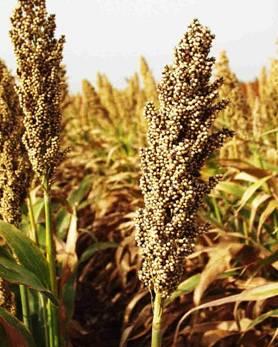By Matt Styslinger
Sorghum is Africa’s contribution to the world’s major food crops, with only rice, wheat, maize, and potatoes playing a larger role. Collectively, these five crops provide over 85 percent of all human energy. Sorghum was eaten in Egypt 4,000 years ago, and today is Africa’s second most important cereal. Ethiopia is the center of the crop’s diversity and sorghum is still an important staple food for most of the Horn of Africa. It has long been a staple food in South Asia,brought by traders as many as 20 centuries ago.

Sorghum is an extremely versatile crop. It can be cooked like rice, made into porridge, malted for beer, baked into flatbreads, and popped like popcorn. The sorghum plant is often used as hay, and the stems are used for buildings, fences, and firewood. And the seeds are commonly used as livestock feed. The sorghum kernel is about 70 percent carbohydrate and 12 percent protein—very much like wheat and maize—but the grain has more vitamin B than maize.
Sorghum is drought resistant, has adapted to water-logging from heavy rain, and can grow in both temperate and tropical zones. It is an important mainstay in sub-Saharan Africa’s most food insecure communities. Sorghum thrives in many marginal and difficult croplands, and can produce up to three harvests a year.
Long established throughout Asia and Africa, sorghum has now become important in Latin America as well. The crop has gained prominence in Mexico over the past half-century, and the number of hectares of sorghum planted in the country grew over 1,000 percent from 1958 to 1980. Mexico has large areas of dry farmland, and sorghum requires less water than maize and wheat. Sorghum is mainly used as an animal feed in Mexico, and now supplies 74 percent of Mexico’s feed stocks.
Africa now produces 20 million tons of sorghum per year, a third of the world total. Its production in Africa has increased steadily, by about 55 percent, over the last 25 years. But for all of its prominence, it is not very heavily supported by policy makers and scientific research. It is still largely a subsistence crop, and there has not been extensive research to develop improved varieties. But that could change, as demand for sorghum increases. It’s increasingly become a popular ingredient for sorghum beer, instant porridge, vegetable oil, adhesives, waxes, and dyes.
Last year, Dr. Gebisa Ejeta in Ethiopia won the World Food Prize for his hybrid varieties of sorghum. Dr. Ejeta’s sorghums are more drought resistant and hold up well against striga —a parasitic weed that attaches itself to the roots of cereals, such as sorghum, and deprives them of necessary nutrients. These hybrids have dramatically increased the production of the grain and made it a more viable food crop for millions of people in sub-Saharan Africa.
To learn more about vegetables indigenous to Africa, read Native African Vegetables Could Help Solve Food Crises, Traditional Food Crops Provide Community Resilience in Face of Climate Change, Kenyan Professor Promotes Indigenous Food to Solve Climate Change Food Crisis, Amaranth: Food Production Without Attention, Pigeonpea: A Little Crop That’s Come a Long Way, Seeds, Seeds, Seeds: Egusi the Miracle Melon, and Celosia: Nature’s Prettiest Vegetable.
Matt Styslinger is a research intern with the Nourishing the Planet project.

Danielle Nierenberg, an expert on livestock and sustainability, currently serves as Project Director of State of World 2011 for the Worldwatch Institute, a Washington, DC-based environmental think tank. Her knowledge of factory farming and its global spread and sustainable agriculture has been cited widely in the New York Times Magazine, the International Herald Tribune, the Washington Post, and
other publications.
Danielle worked for two years as a Peace Corps volunteer in the Dominican Republic. She is currently traveling across Africa looking at innovations that are working to alleviate hunger and poverty and blogging everyday at Worldwatch Institute’s Nourishing the Planet. She has a regular column with the Mail & Guardian, the Kansas City Star, and the Huffington Post and her writing was been featured in newspapers across Africa including the Cape Town Argus, the Zambia Daily Mail, Coast Week (Kenya), and other African publications. She holds an M.S. in agriculture, food, and environment from Tufts University and a B.A. in environmental policy from Monmouth College.








